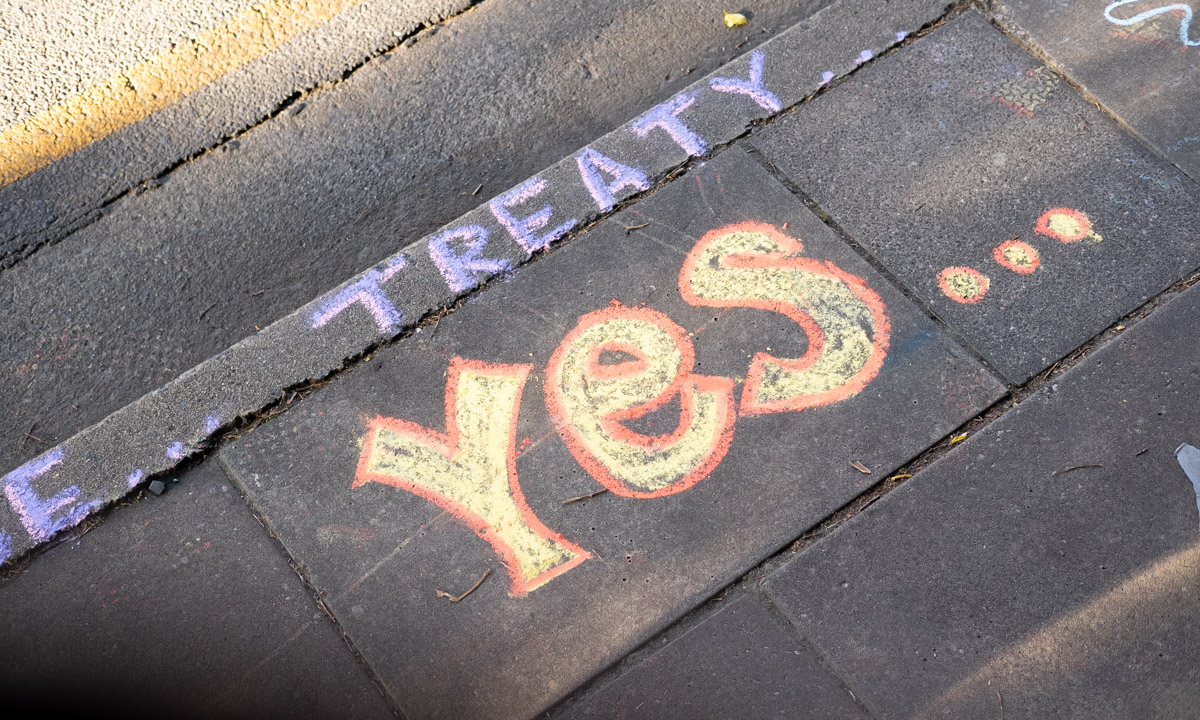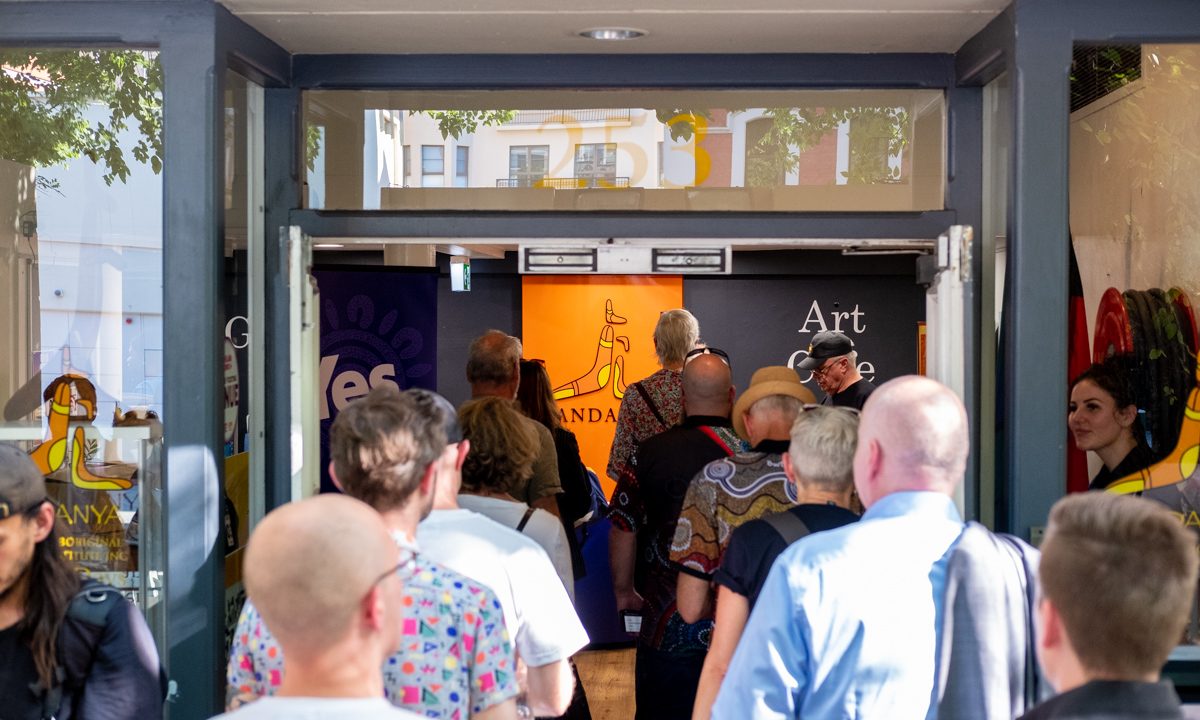The voices behind the Voice
Words: Angela Skujins
Pictures: Johnny von Einem
The ‘yes’ campaign for the national Voice to Parliament kicked off last week in Tandanya — Australia’s oldest Aboriginal and Torres Strait Islander multi-arts and cultural venue.
It was mere hours after the South Australian Voice legislation passed its first parliamentary political hurdle.
We spoke to attendees at the event about what they hope will come from the two levels of voice.
—
CityMag could smell the burning plant matter in Uncle Major ‘Moogy’ Sumner’s coolamon before we could see him fanning its embers.
It’s 4:55pm on Thursday, 23 February, and the painted up Ngarrindjeri and Kaurna elder is conducting a smoking ceremony on the steps outside Tandanya National Aboriginal Cultural Institute to clear “negative energy”, he tells CityMag.
Hundreds of guests file through the smoke and the doors of the 34-year-old cultural institution, where celebrations have begun for the national campaign launch for the yes vote for the Voice to Parliament referendum, which is expected to take place later this year.

Outside Tandanya
Union representatives, politicians, volunteers, musicians, allies, and First Nations people from as far as the Top End stand in the 39°C heat, wearing ‘yes’ badges, stickers and t-shirts to show their support for the constitutional reform.
As we speak to Uncle Moogy, South Australia’s Minister for Aboriginal Affairs Kyam Maher walks past. He’s jubilant. The Attorney-General, who is of Tasmanian Aboriginal heritage, asks the elder if he’s heard the good news: South Australia’s own bill for a Voice to Parliament “got through the Upper House about an hour ago”, he says. We ask Uncle Moogy about the difference between the national Voice and the state Voice. “I don’t know,” he answers.
What he does know is Traditional Owners of this country “should have a say in everything”, from land care to health outcomes. “Aboriginal people have got to have a voice right across the country,” Uncle Moogy says.
As we make our way into the hall, where bottles of sparkling wine pop and the roar of conversation swells, Uncle Moogy asks us a favour: could we explain the difference between the two pieces of legislation once we find out?

THE NATIONAL VOICE
—
Australians will head to the polls sometime between October and December this year to cast a vote on whether they support a national Voice to Parliament. This matter must be decided with a referendum, as tweaks to the Commonwealth Constitution need “the approval of the people”, the Australian Electoral Commission states on its website.
When Labor won the federal election in May 2022, Prime Minister Anthony Albanese said in his victory speech he would create a “voice enshrined in our constitution”. On the day of the yes campaign launch for the Voice to Parliament, he explained that the constitutional modification aims to do “two things only”.
“It’s about recognition of Aboriginal and Torres Strait Islander Peoples in our nation’s birth certificate and it’s about consultation,” the Prime Minister said outside Flinders Medical Centre. He was in town by coincidence, spruiking a different policy.
The concept of the Voice is based on a definition reached by a convention of 250 Indigenous representatives who convened in Uluru in May 2017. The statement the group released following the convention, known as the Uluru Statement from the Heart, called for “the establishment of a First Nations Voice enshrined in the Constitution”.
After the establishment of the Voice, the Uluru Statement calls for the creation of a Makarrata Commission, which will undertake a process of treaty-making and truth-telling, according to the Uluru Statement website.
But there is some opposition to the Voice from within First Nations communities. Federal Senator Lidia Thorpe, who wants to see a Treaty established first, ejected herself from the Greens, who are in support of a Voice. A Treaty would be a binding agreement setting out terms of engagement and obligations between the two signed parties: the colonising body and Indigenous peoples. New Zealand, the US and Canada all have such treaties.
Veteran journalist Stan Grant also penned an article about the divided opinion, articulating that First Nations Australians are not a homogeneous body. The 2021 Census counted 984,000 Aboriginal and Torres Strait Islanders, and their views vary.
In the line waiting to enter Tandanya, we speak to Leon Epong, a Mandaburra man working for St Vincent de Paul in Queensland. Leon tells us he travelled here on behalf of his organisation to support the Voice, and he personally believes in the mechanism’s possibilities.
“If it’s there to reach better outcomes for our people, and for the betterment of the whole country, it is worth doing,” he says. “You’ve got Closing the Gap agenda, so it needs to ensure that that improves all of those targets over time. But also… I don’t think reconciliation can be genuinely achieved without something like this.”

Daniel Rosendale
Once inside, we meet 24-year-old Daniel Rosendale, a Kuku Yalanji and Guugu Yimithirr man from Far North Queensland. Daniel first read the Uluru Statement from the Heart in 2019 as a 20-year-old. He says it gave him goosebumps. “It was a very moving moment for me,” he says.
Daniel says for Australia to overwhelmingly support this constitutional change would be the country taking “the right step forward”.
“We’re a young nation; we’re a progressive nation, and we’re a nation that wants to do good,” he says.
Former Aboriginal Legal Rights Movement CEO, Narungga woman Cheryl Axleby, is also in attendance. Now head of SA Aboriginal Housing, she wears a big ‘yes’ badge on her shirt. She says the federal Voice is about Australia maturing as a nation.
“It’s also important to then move forward together, and say that we are all now recognised,” she says.
When we ask whether the Voice will work, and whether politicians in parliament will listen, Cheryl says it’s better than the current reality. “What do we have now?” she asks. “We don’t have anything. We have policy and political context handed down to us. Now it’s time for us to be on [an] equal-level playing field, and it’s time for empowerment of our people.”
Phil Saunders, interim CEO of Tandanya, takes the stage to address the crowd of onlookers. He speaks of the cultural significance of hosting the national political push at this cultural centre.
“Tandanya is the spiritual home of the grassroots movement in South Australia,” he says, listing off political progenitors No Fixed Address, who formed in Adelaide.
Arrernte and Kalkadoon film director Rachel Perkins – responsible for creating ground-breaking works such as the three-part television series The Australian Wars and films Jasper Jones and Mabo – takes the stage soon after to remind the crowd of another piece of lesser-known local history.
“Sixty-four years ago, on the 18th of February, three Aboriginal men and their allies — a group of non-Aboriginal people — came into this town and met, and they [formed] the Federal Council for Aboriginal Advancement,” she says. The group lobbied in favour of the 1967 Referendum on Aboriginal Australians, which received overwhelming support to include Aboriginal and Torres Strait Islanders in the Constitution as Australians.

Dale Agius
Dale Agius, South Australia’s inaugural Commissioner for First Nations Voice, takes the stage, and instead of speaking on South Australia’s past, he focusses on now and the impending future. Over the past six months, the Kaurna, Narungga, Ngadjuri and Ngarrindjeri man has spearheaded consultation with community groups, organisations and hundreds of individuals across the state to develop a state-focussed Voice.
“So, what’s happening here in South Australia?” he asks with a wry grin. “So much, if you haven’t heard.”
Dale is referring to SA Labor’s own push for a state-level Voice to Parliament, referred to as the First Nations Voice Bill 2023. A report tabled in parliament last year, which formed the basis of the bill, found the South Australian Aboriginal community who were consulted about the bill want a direct Voice to state parliament.
They also want the Voice to be elected by First Nations people; a Voice to represent the diversity of South Australian First Nations communities; and “direct access” to government decision-makers, including cabinet members and chief executives, the report states.
“South Australia is now set to consider this legislation in the Lower House in the coming weeks,” Dale continues. In true hype-man format, he closes out telling the audience to “watch this space”, saying all those in attendance are “gold; we are black gold”.

THE STATE VOICE
—
SA Labor went to the 2022 state elections with the promise of implementing the Uluru Statement from the Heart if they formed government. They announced their first hint of the policy in November last year, saying in a press release, “South Australia is leading the way with historic legislation that provides for a directly elected First Nations Voice to our Parliament.”

Unlike the federal Voice, a state Voice will not be put to the community in the form of a referendum. It will go through parliament like an ordinary bill. On Thursday last week, the First Nations Voice Bill 2023 passed its first political hurdle by receiving enough support in the Upper House to move through to the Lower House, where it will be debated and voted on in the next couple of weeks.
Similar to the national Voice, teh state voice has attracted political hostility. As reported by our sister news organisation InDaily, the Liberals are against the bill, saying the legislation is “rushed” and flawed. This scepticism is in line with the national Liberal Party’s views, as Opposition Leader Peter Dutton has repeatedly questioned how the federal Voice will function, as the referendum only asks for in-principle support. Dutton’s party has not officially announced its position on a national Voice, though.
Regardless, the First Nations Voice Bill is expected to pass parliament in South Australia as it has the support of the Greens.

South Australian native title organisations have also expressed their opposition to the bill. They previously stated their concerns that the Voice could bypass established individual native title groups. In response to this, the State Government introduced provisions ensuring the Voice would not impact native title agreements or other First Nations organisations.
At the national yes launch, punters were provided with a yellow A4 piece of paper explaining how the First Nations Voice to South Australian Parliament will progress. Elections will be held for multiple regions, choosing a local First Nations Voice, which will consist of a 12-person body of Indigenous leaders. There will be an equal number of men and women in each leadership group.
Each group will “make [an] annual address” to parliament, as well as comment on bills and present reports, the document says. They will also “engage” ministers and chief executives.
Leigh Shears is a non-Aboriginal man covered in tattoos and wearing beat-up RM Williams boots. He is the secretary of the Hunters Workers Union in New South Wales, and says his union is supporting the federal Voice because it is the right thing to do. “It’s time to do what is right, what is fair and what is reasonable,” he says.
Although there is a long way to go between now and the referendum, and the state Voice is only beginning to warm up its vocal cords, there are masses waiting to hear it. Rachel Perkins, the director, put it well: “we are taking the Australian people on board with us.”






